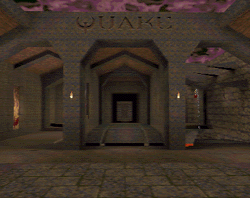Introduction |
|
|
 The idea of creating virtual worlds in which we can explore a place
that looks as real as our own was popularized in William Gibson's book
Neuromancer. That was 10 years ago, long before any computer was
capable of creating a true virtual world for us to fully experience. But
since that time, advancements in computers have given us the ability to
portray worlds which, while not totally immersive like Gibson's 'cyberspace',
have come amazing close to those of the real world. People like John Carmack
have brought us the ability to create a virtual space where we can experience
places and phenomenon that would be otherwise impossible in the real world
- instead of going to a movie and watching the hero defeat the villain
and save the girl we can take an active role as the hero.
The idea of creating virtual worlds in which we can explore a place
that looks as real as our own was popularized in William Gibson's book
Neuromancer. That was 10 years ago, long before any computer was
capable of creating a true virtual world for us to fully experience. But
since that time, advancements in computers have given us the ability to
portray worlds which, while not totally immersive like Gibson's 'cyberspace',
have come amazing close to those of the real world. People like John Carmack
have brought us the ability to create a virtual space where we can experience
places and phenomenon that would be otherwise impossible in the real world
- instead of going to a movie and watching the hero defeat the villain
and save the girl we can take an active role as the hero.
Note: This tutorial has been made over the course of several different versions of Worldcraft. Not all screenshots will look exactly the same as your screen will in all cases. Don't panic and start e-mailing us or throwing yourselves off cliffs :) |
| [Previous] | [Table of Contents] | [Next] |